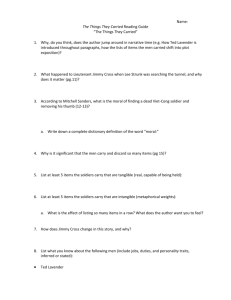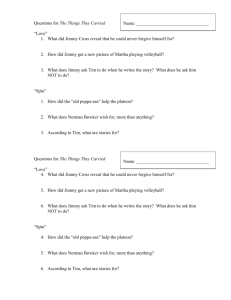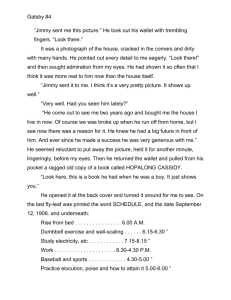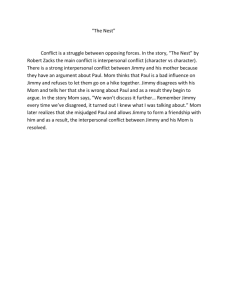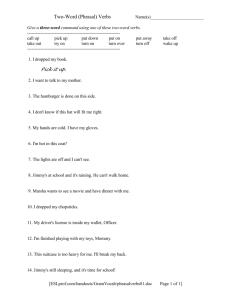Jimmy Corrigan By Shanna Killeen
advertisement
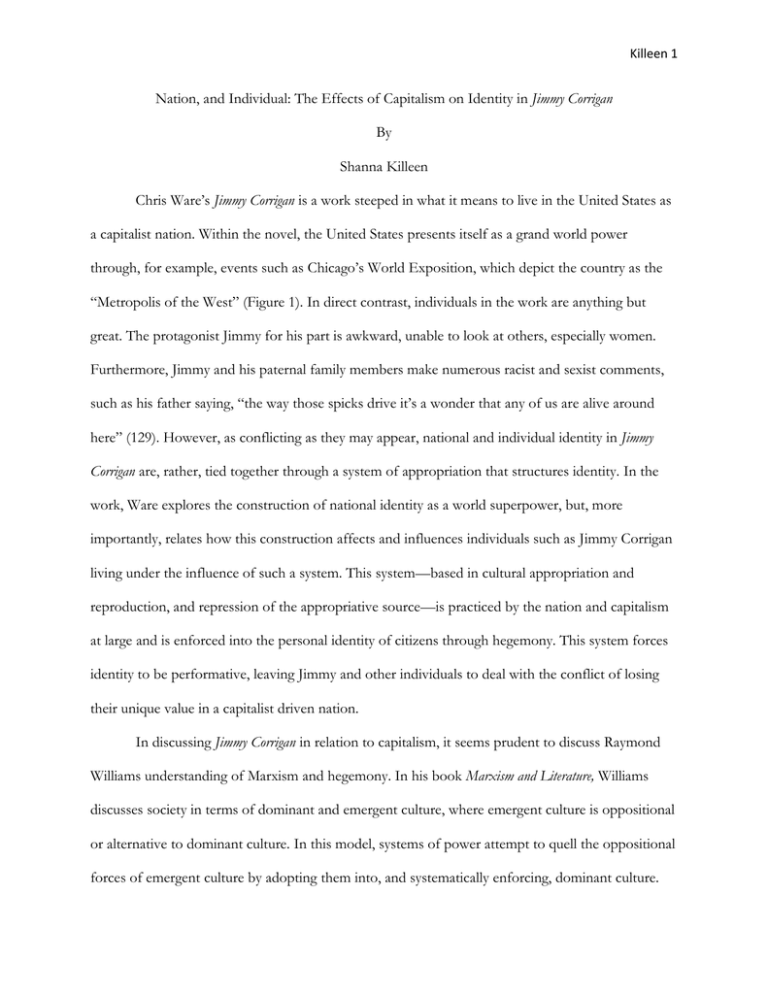
Killeen 1 Nation, and Individual: The Effects of Capitalism on Identity in Jimmy Corrigan By Shanna Killeen Chris Ware’s Jimmy Corrigan is a work steeped in what it means to live in the United States as a capitalist nation. Within the novel, the United States presents itself as a grand world power through, for example, events such as Chicago’s World Exposition, which depict the country as the “Metropolis of the West” (Figure 1). In direct contrast, individuals in the work are anything but great. The protagonist Jimmy for his part is awkward, unable to look at others, especially women. Furthermore, Jimmy and his paternal family members make numerous racist and sexist comments, such as his father saying, “the way those spicks drive it’s a wonder that any of us are alive around here” (129). However, as conflicting as they may appear, national and individual identity in Jimmy Corrigan are, rather, tied together through a system of appropriation that structures identity. In the work, Ware explores the construction of national identity as a world superpower, but, more importantly, relates how this construction affects and influences individuals such as Jimmy Corrigan living under the influence of such a system. This system—based in cultural appropriation and reproduction, and repression of the appropriative source—is practiced by the nation and capitalism at large and is enforced into the personal identity of citizens through hegemony. This system forces identity to be performative, leaving Jimmy and other individuals to deal with the conflict of losing their unique value in a capitalist driven nation. In discussing Jimmy Corrigan in relation to capitalism, it seems prudent to discuss Raymond Williams understanding of Marxism and hegemony. In his book Marxism and Literature, Williams discusses society in terms of dominant and emergent culture, where emergent culture is oppositional or alternative to dominant culture. In this model, systems of power attempt to quell the oppositional forces of emergent culture by adopting them into, and systematically enforcing, dominant culture. Killeen 2 Dominant culture is expressed and enforced through hegemony, which Williams sees as both a cultural and ideological imposition of power that permeates all of life. Hegemony in these terms is indirect, passed down to individuals through various channels such as media/propaganda, family, and education. In Jimmy Corrigan, much of what defines national identity is predicated upon the adoption of emergent culture into the dominant culture. However, in the work, emergent culture is not simply adopted by the Unites States, but also appropriated to an extent that the nation uses this culture to define the nation as great. Therefore, the United States adopts emergent culture only to serves the purpose of advocating a unique, powerful America, rather than identifying itself as a nation constructed by the merging and interaction of multiple cultures. This can be seen clearly in figures 2 and 3, which function as flashcards. In figure 3, the panel titled “A Declaration of Glory,” in its title alone, conveys the idea of the US as superior, invoking the Declaration of Independence and tying it into the notion of glory. However, the explanation that follows describes a store that “procures” goods from “foreign lands” to sell at “an affordable price to citizens of modest means” (173). This seems to suggest that the glory of the US, particularly as a capitalist power, is predicated upon an appropriation of foreign culture into the US culture at large. This idea is more directly approached by Ware through his emphasis on the peach, which he describes in the ending “Corrigenda,” a section that functions as short encyclopedia. Here Ware describes the peach as “Native to China…having been spread by the Romans and then brought by the Spanish to America” (388). This definition reflects an earlier appearance of the peach when Jimmy first arrives in the airport. Here, a man takes a peach from the fruit basket Jimmy brought for his father. Invoking the fruit’s history, the man emphasizes that the peach is one of the “biggest rosaceous crops in this country,” further asking Jimmy “Do you know where the peach is originally from, son? Do you? Huh?” (37). This emphasis on origin is in contrast to the peach’s appearance in the exhibitions at Chicago’s Killeen 3 World Fair, which Jimmy’s grandfather attends as a child. Here the fruit is representing “the State of Tennessee” (281). Through this contrast of origin and representation, Ware is asking the reader to pay close attention to the United States’ relationship to foreign or non-dominant culture, emphasizing US cultural appropriation in contrast to its claims of uniqueness. Moreover, Ware is emphasizing the fact that, in order to achieve this uniqueness, the origins of appropriative sources have to be obscured or effaced. In essence, the US does not just allow foreign culture to merge with its own, but takes it, erases its cultural roots, and declares it as its own in service of an image of American uniqueness. However, while the nation strives to be unique, the US cannot escape the fact that, through its very dependence on appropriating culture, its own identity loses the unique value it is trying to establish. In essence, the very act of appropriating involves a form of replication, literal in the case of the peach, where a culture is reproduced within the dominant cultural context. This is done with so many sources within the United States that true unique value is technically abridged despite the image that the nation propagates. US appropriation certainly has a tremendous effect on the shaping of national identity; however, it has an inescapable affect on the shaping of personal identity as well. The process of appropriation as a means of forming identity is so heavily ingrained that personal identity becomes appropriative and performative. Through hegemony, the nation enforces appropriation and the formation of the identity in the image of dominant culture. Arguably, the two most influential sources of hegemony are family and national propoganda, and through these sources, Jimmy and other individuals in the work appropriate and construct their identities. National propaganda, for its part, abounds in the work, particularly in the sections about Jimmy’s grandfather, which are set in the time leading up to Chicago’s World Exposition, which declares the greatness of capitalist and industrial America by calling Chicago “The Metropolis of the West” (78). This propaganda is not Killeen 4 just simply present, but has a marked influence on Jimmy and his construction of identity. In fact, this national propaganda is so strong that it fills the gaps left by the absence of paternal figures. This is demonstrated in the image of Superman. As a cultural icon, Superman represents the ideal image of America, as the strongest, fastest, most powerful man/nation. Superman represents an ideal vision of America where it becomes the strong-arm of justice. This propaganda is so strong that the figure of Superman fills in as a paternal figure for Jimmy, literally when the man playing Superman at a local car show comes home with Jimmy and his mother, and psychologically as seen in the various instances that he appears in Jimmy’s imagination. This propaganda begins to play its own role in influencing the appropriative formation of individual identity. This can be seen in the various panels in the work that place Jimmy as a character in his own comic book where he becomes “The Smartest Kid on Earth” (figure 4). In these instances, Jimmy is psychologically appropriating the role of a superhero in the vein of US idealism. Jimmy further constructs his identity through appropriation from family and past history, making his own identity inherently performative. In the narrative, Ware places an emphasis on looking at familial roots through the patriarchal line, as seen through Jimmy traveling to meet his father, as well as the narrative’s focus on Jimmy’s father, grandfather, and great-grandfather as sources of familial history and experience. Particularly in Jimmy visiting his father, there appears to be a conscious searching and recognition of the influence of past sources (in this case relatives) on the shaping of an individual. This is conveyed by Ware in the ways that elements of the family’s past influence Jimmy in the present day. Elements and key images in Jimmy’s story mirror the stories of his paternal ancestors, particularly his grandfather. The projector light, which the grandfather witnesses his own father using, and which he then imagines reaching out to the moon (figure 5), appears in Jimmy’s dreams as a robot with a searching light (figure 6). Additionally, the metal horse the grandfather wants to create and the real horse he takes care of, appear in other dreams that Killeen 5 Jimmy has where he is growing up on a farm. The images of the past appear more directly in Jimmy’s real life as well, such as the crutch Jimmy uses and his injured foot, which mirrors the injured leg of his great-grandfather. The fact that Jimmy does not really need the crutch, since he only has a minor sprain, and that he uses the crutch incorrectly, putting his weight on the injured foot, indicates a performative nature to these elements, indicating the ways in which Jimmy appropriates the familial past in order to construct his identity. However, just like the US loses its unique value through the very nature of an appropriative system, because Jimmy constructs his identity based on appropriating propaganda and familial history, he loses his own unique value. Through an appropriative system of identity construction, Jimmy himself becomes like a commodity, a reproduced item made in the image of America, one of many, losing the unique value of his identity through a simulation of the commercial replication process within identity. The identity that Jimmy seems to take on from his paternal ancestors appears directly like a form of replication. Not only does Jimmy mirror aspects of his ancestors’ lives, but he also shares his name and physical appearance with both his father and grandfather. In this way, Jimmy is nearly indestinguishable from his family, particularly his grandfather. Therefore, individual identity itself is replicated through appropriation and loses its unique value in the process. However, while hegemony enforces a system of appropriation, individuals seek to resist the resulting removal of unique value. Like the United States ignores the fact that it has appropriated its identity of greatness, through a disregard of familial history and national identity, individuals resist the performative nature of identity imposed by a capitalist and imperialist system. This is marked generally through a large disregard for the elderly in the story. The elderly are split from society, hidden from view once their identity is appropriated. For example, while Ware initially depicts Jimmy’s mother as needy, he later reveals that she is in a nursing home, signifying particularly Jimmy’s abandonment of his mother, and more generally the wider trend of ignoring the elderly by Killeen 6 placing them away from mainstream society. This disregard is highlighted by the comment of a young boy in the diner when Jimmy sees his grandfather for the first time. As Jimmy looks at his grandfather, the boy comments on how strange it is that someone so old “still walks around and does stuff,” suggesting the idea that the elderly are split from society not only socially but are also physically expected to have as little presence in the physical world of society as possible (189). This split from family, from appropriative sources is more directly seen within Jimmy through the consistent physical division between the characters along the paternal line. Jimmy, until he is a fullygrown adult, never meets his dad and grandfather nor has any contact with them, while his grandfather is abandoned by his own father as a small child. In fact, only after his father passes away is Jimmy able to finally look at a woman directly, as if by losing his tie to his paternal source of identity, Jimmy can now begin venturing out into the world and forming his own identity, as if he is just becoming an adult, despite being more than 30-years old. Moreover, before his father’s death, Jimmy fantasizes about killing his father, expressing a desire to be free of familial influences on identity even before his father actually dies. This resistance can be similarly seen in terms of national identity, as Jimmy imagines the death of Superman. In one instance (figure 7), Jimmy imagines Superman jumping off a building and falling dead on the street. Later, Jimmy imagines himself at the top of the same building about to jump (figure 8). This correlation suggests a recognized connection between Jimmy and the figure of Superman as a partial influence on Jimmy’s identity. However, more importantly, it shows a desire on the part of Jimmy to be free of the confines of appropriative identity. In much the way he feels partially freed from his paternal ties and familial appropriation when his father passes away, Jimmy seems to be equating the death of Superman to his own constructed identity, suggesting his desire to be free of propaganda. Therefore, while Jimmy demonstrates a simultaneous desire to mimic the nation’s appropriative formation of identity, he also struggles to be identified as a unique individual. Killeen 7 However, just as the United States as nation cannot escape the appropriative cultural forces that construct it’s identity (even if it does an effective job of suppressing them), Jimmy cannot escape familial and national influences on his identity. Familial appropriation is so ingrained that Jimmy cannot escape from his dependence on family ties. In the end, Jimmy still has his crutch, both literally and symbolically demonstrating his continued reliance on his ancestors’ pasts to construct his own identity. The fact that Jimmy’s identity remains so dependent on familial ties that are barely present, leads to two conclusions. First, family as a source of hegemony is so strong that it influences identity even when no physical family ties exist. In fact, familial hegemony is so inescapably strong that it moves over the divides of space as well as time, as suggested by the mirroring that takes place between Jimmy and his ancestors. Second, national propaganda is so influential, it supersedes the need for familial influence, such as is seen with Superman becoming a father figure for Jimmy. Furthermore, in the very last image of Jimmy, he is flying with Superman. If Jimmy is not fully adopting national identity, he is demonstrating a significant lack of resistance to propaganda as a source of identity, suggesting the inevitable inescapability of its force. In terms of both family and propaganda, the hegemonic influences of the United States impose a model of appropriation on the individual that is inescapable. Throughout Jimmy Corrigan, Ware explores the complex relationship between nation and individual under the capitalist system. Unlike a simpler notion of this relationship, the US has a significant influence on individuals, shaping them so fully that their identity becomes just another reproduced imitation in the capitalist system. Identity becomes inescapably appropriative and performative. Once this more complex relationship is taken into account, it becomes important to look not just at Jimmy Corrigan in terms of the construction of personal identity at large, but also in terms of more specific forms of identity within this capitalist system, such as construction of race and gender. Jimmy’s experience, while informative, is just one perspective on identity, a perspective Killeen 8 coming from a white, male dominant culture. Therefore, it seems important to take into account other perspectives on identity within the work so that we can further delve into what it truly means to be American in a capitalist era. Work Cited Williams, Raymond. Marxism and Literature. Oxford: Oxford University Press, 1977. Print. Ware, Chris. Jimmy Corrigan: The Smartest Kid on Earth. New York: Pantheon, 2000. Print. Killeen 9 Figure 1 Figure 2 Figure 3 Figure 4 Figure 5 Figure 6 Figure 7 Figure 8 Work Cited Williams, Raymond. Marxism and Literature. Oxford: Oxford University Press, 1977. Print. Ware, Chris. Jimmy Corrigan: The Smartest Kid on Earth. New York: Pantheon, 2000. Print.
